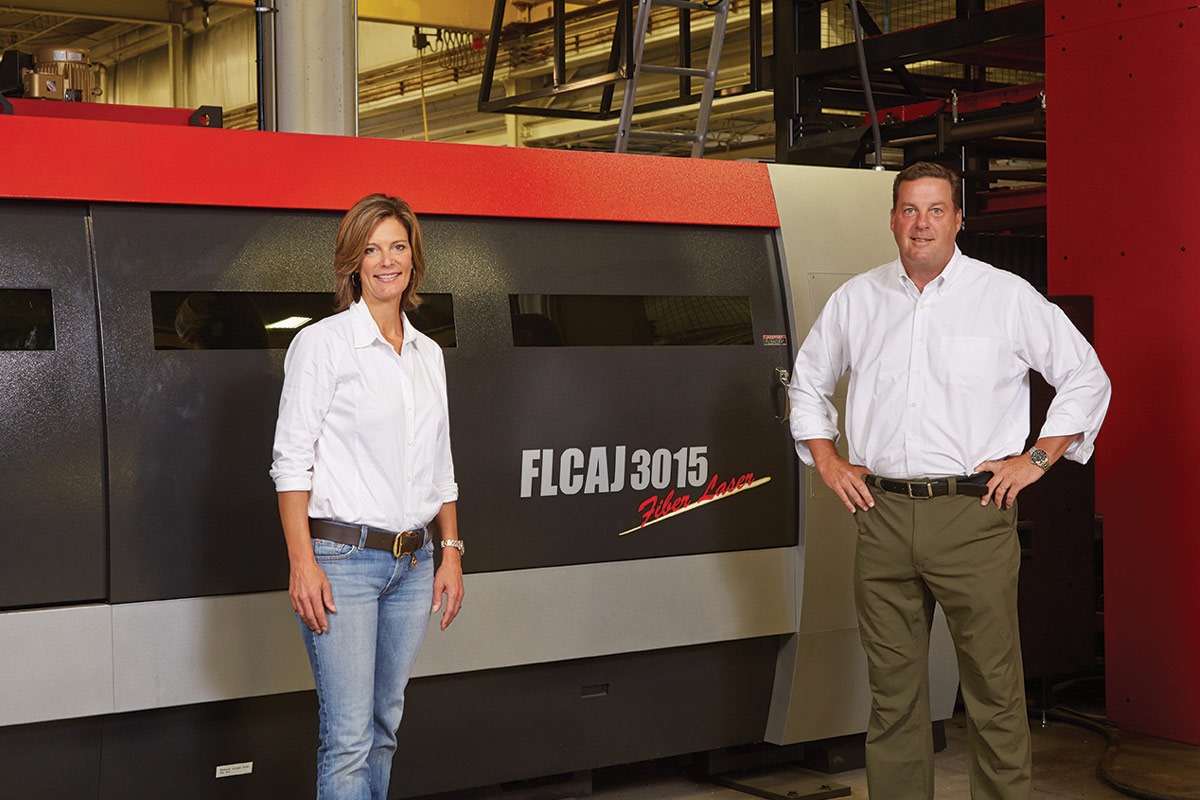
Machine technology has made a quantum leap forward. We started with a 10-ft. shear and a 1973 Wiedematic turret press. We grew into three turrets before we bought our first laser. That laser changed our business forever. Today, with our new Amada Dr. Abe software package, if we get a good 3D model from a customer, it will filter right through the programming package and automatically program it in the [press] brake and in the laser.
Another change is that customers want their parts finished and assembled. When we first bought the company, we didn’t powder coat anything, and now, it’s the exact opposite. We probably coat 99 percent of the steel that goes out, as well as perform functions like prepackaging of parts and assembly.
We still do what we have always done: We cut steel. We bend steel. We weld it. We grind it. We powder coat it. And we ship it. It’s just the ways we program it and the ways we cut and bend it are much more sophisticated, which has enabled us to get a lot more product out the door and compete with the rest of the world.
Marian Lauer: A lot of people think you don’t necessarily need a skilled person running automated equipment. In actuality, you do. The operator needs to make sure the products are correct. It’s not ‘just a guy’; it’s somebody who knows what they are doing.
Marian Lauer: When we interview, we’re not necessarily looking for somebody who already has the skills because, as a job shop, we don’t do just one or two things. Often, we can’t find press brake operators who understand the nuances of running a press brake. So we’re looking for a person who has an aptitude to learn it, and we do a lot of in-house training, especially for that position.
Jim Lauer: Younger employees can pick up the programming in a minute—it’s like running a video game. But you also need to understand how the steel works, how it bends, how to solve problems when they come up. We have started to tap into some of the local colleges and have found that engineering students are a great resource. They are up-to-date on the latest technology, and they can do things quickly and efficiently.
Marian Lauer: Just because it works on paper doesn’t mean that you can fabricate it that way. We sometimes get drawings with so much engineering in them that it ends up creating a super expensive, elaborate part—when it really just needs to fit, form and function. By working here, these young people can see how a part is being formed and what kinds of real-world obstacles it might face.
 It’s about getting to that next level, and you never know what that’s going to look like until you are standing there.
It’s about getting to that next level, and you never know what that’s going to look like until you are standing there. 
Marian Lauer: You don’t panic that a decision is going to be made without an owner’s viewpoint. It is nice to know the other person is totally vested. We have different skill sets. I end up doing a lot of the detail work—HR and processes—and Jim handles the sales and the big-picture ideas. We make a good team.
Marian Lauer: When we started due diligence on the lasers, we realized that if we got an automated tower, the height limits of the building meant we would need to purchase a new building. That was another leap of faith where we said, “OK, the numbers don’t add up right now but can we possibly do this and grow enough to make it work?”
Jim Lauer: I think we put $2.5 million into the company that year—the laser, the tower, a new press brake and the building. That was a big year for us.
Another memorable moment was one of our first Christmas parties. We were probably up to about 20 employees at the time. We had a bowling party, and there were 40 or 50 people there. I was taken aback at how real it became. As an owner, you realize how important your everyday decisions are for all those families.
Finally, we made the Super Bowl two years ago. Fanuc Robotics is one of our largest customers, and there was a Super Bowl commercial that featured one of the robots we made parts for. We couldn’t believe it. I always get a kick out of seeing parts that we’ve made or have helped design somewhere out in the world.
Marian Lauer: We look 18 months in advance and ask ourselves what we are going to need to be successful. If we want to grow a certain amount, are we going to need more room? Are we going to need another laser? You start doing your due diligence, and through [that process], you look at other companies to learn what obstacles they have and how they are running their business. You can learn a lot from others.
Jim Lauer: It’s about getting to that next level, and you never know what that’s going to look like until you are standing there.
www.weaverfab.com.